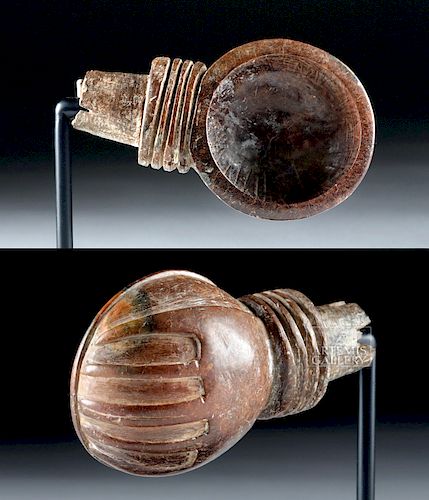Syrian Stone Libation Bowl - Hand Cupping
Lot 97b
About Seller
Artemis Gallery
686 S Taylor Ave, Ste 106
Louisville, CO 80027
United States
Selling antiquities, ancient and ethnographic art online since 1993, Artemis Gallery specializes in Classical Antiquities (Egyptian, Greek, Roman, Near Eastern), Asian, Pre-Columbian, African / Tribal / Oceanographic art. Our extensive inventory includes pottery, stone, metal, wood, glass and textil...Read more
Estimate:
$2,500 - $3,500
Absentee vs Live bid
Two ways to bid:
- Leave a max absentee bid and the platform will bid on your behalf up to your maximum bid during the live auction.
- Bid live during the auction and your bids will be submitted real-time to the auctioneer.
Bid Increments
| Price | Bid Increment |
|---|---|
| $0 | $25 |
| $300 | $50 |
| $1,000 | $100 |
| $2,000 | $250 |
| $5,000 | $500 |
| $10,000 | $1,000 |
| $20,000 | $2,500 |
| $50,000 | $5,000 |
| $100,000 | $10,000 |
| $200,000 | $20,000 |
About Auction
By Artemis Gallery
Feb 21, 2019
Set Reminder
2019-02-21 10:00:00
2019-02-21 10:00:00
America/New_York
Bidsquare
Bidsquare : Exceptional Antiquities, Asian, Ethnographic
https://www.bidsquare.com/auctions/artemis-gallery/exceptional-antiquities-asian-ethnographic-3858
An important one-day auction featuring museum-worthy examples of Egyptian, Greek, Roman, Etruscan, Near Eastern, Far East / Asian, Pre-Columbian, African / Tribal, Oceanic, Native American, Spanish Colonial, Russian, Fossils, Ancient Jewelry, Fine Art, so much more! Artemis Gallery info@artemisgallery.com
An important one-day auction featuring museum-worthy examples of Egyptian, Greek, Roman, Etruscan, Near Eastern, Far East / Asian, Pre-Columbian, African / Tribal, Oceanic, Native American, Spanish Colonial, Russian, Fossils, Ancient Jewelry, Fine Art, so much more! Artemis Gallery info@artemisgallery.com
- Lot Description
Ancient Near East, the Levant, ca. 900 to 800 BCE. A beautiful libation bowl, hand-carved from an earthy brown piece of steatite. The bowl is shallow, with a flat rim, its thin edge a testament to the skill of the artist who carved it. On the underside, in low relief, is a human hand, carved with its fingers extended, as if cupping the bowl. A socket-like extension extends from one side, with a thick collar made of four deeply incised rings. The socket terminates in four petal-like edges that flare outward slightly. The bowl interior is lightly scored, with wear as if it was scraped both horizontally and vertically. Size: 2.6" L x 4.25" W x 1" H (6.6 cm x 10.8 cm x 2.5 cm); 4.9" H (12.4 cm) on included custom stand.
Stone libation bowls have been found throughout the ancient Near East and ancient Mediterranean, but based on frequency of finds, they seem to have originated in the region of modern day Northern Syria and dispersed from there. Many have animal motifs, especially lions, but there are a few with cupping hands. For example, a partial steatite bowl found at Tel Zeror depicts two curved hands cupping the bowl; another with a single hand, as here, is known from Catal Hoyuk in central Turkey. What is the meaning of the hand holding the bowl? Archaeologist Hideo Ogawa (see below) speculated that the hand on steatite libation bowls may be a symbol of a god - he writes, "Very often divine power was represented by hands in ancient Near East. In Exodus we read about God's miraculous power, which was represented by his hand, the hands of Moses and Aaron and the stick in Moses' hand… The hands of Aton of Akhnaton brought his life giving power to the royal family and the world. There is found in the Hatzor sanctuary a famous representation of hands which may express the saving power of the ancestral deity" (pg. 40).
A similar style of vessel sold at Christie's New York for $12500 USD in 2015: https://www.christies.com/lotfinder/Lot/a-syrian-stone-libation-bowl-circa-9th-8th-5903881-details.aspx; see a similar example at the Museum of Fine Arts, Boston: https://www.mfa.org/collections/object/ointment-or-libation-bowl-164973
c.f., "A Steatite Bowl from Tel Zeror" by Hideo Ogawa, 1971, Bulletin of the Society for Near Eastern Studies in Japan, Vol. 14, Issue 1.
Provenance: private East Coast, USA collection; ex-William Froelich collection, New York and California (USA) and Saba (Caribbean), acquired in the 1970s
All items legal to buy/sell under U.S. Statute covering cultural patrimony Code 2600, CHAPTER 14, and are guaranteed to be as described or your money back.
A Certificate of Authenticity will accompany all winning bids.
We ship worldwide and handle all shipping in-house for your convenience.
#143607Small loss to end attachment, otherwise in nice condition, with wear commensurate with age and good surface deposits.Condition
- Shipping Info
-
All shipping is handled in-house for your convenience. Your invoice from Artemis Gallery will include shipping calculation instructions. If in doubt, please inquire BEFORE bidding for estimated shipping costs for individual items.
-
- Buyer's Premium



 EUR
EUR CAD
CAD AUD
AUD GBP
GBP MXN
MXN HKD
HKD CNY
CNY MYR
MYR SEK
SEK SGD
SGD CHF
CHF THB
THB

















